ignition Citroen C4 AIRCROSS 2014 1.G Workshop Manual
[x] Cancel search | Manufacturer: CITROEN, Model Year: 2014, Model line: C4 AIRCROSS, Model: Citroen C4 AIRCROSS 2014 1.GPages: 368, PDF Size: 20.37 MB
Page 150 of 368
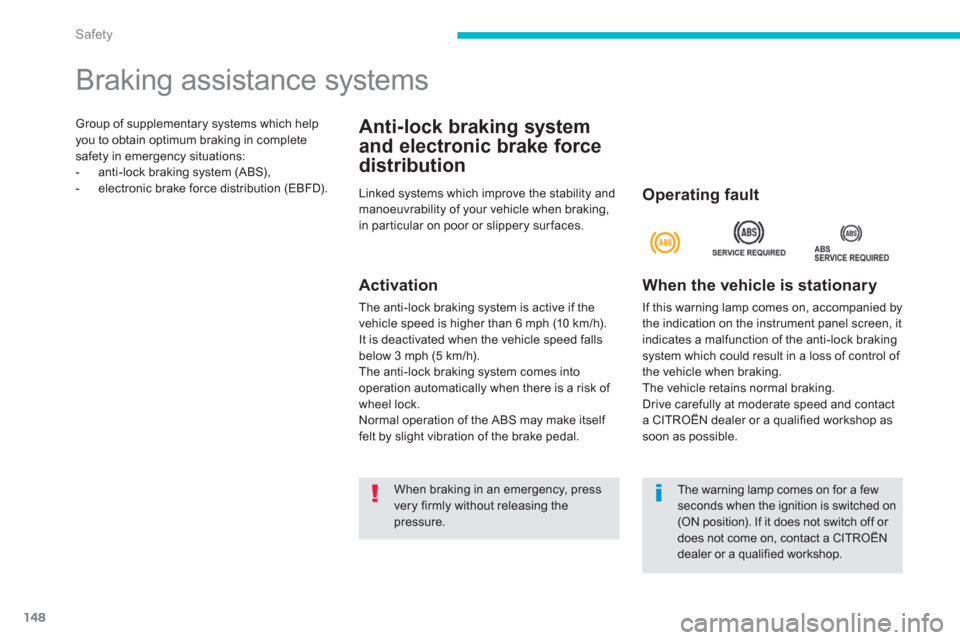
148
Safety
Group of supplementary systems which help
you to obtain optimum braking in complete
safety in emergency situations:
- anti-lock braking system (ABS),
- electronic brake force distribution (EBFD).
Braking assistance systems
Anti-lock braking system
and electronic brake force
distribution
Linked systems which improve the stability and
manoeuvrability of your vehicle when braking,
in particular on poor or slippery sur faces.
Activation
The anti-lock braking system is active if the
vehicle speed is higher than 6 mph (10 km/h).
It is deactivated when the vehicle speed falls
below 3 mph (5 km/h).
The anti-lock braking system comes into
operation automatically when there is a risk of
wheel lock.
Normal operation of the ABS may make itself
felt by slight vibration of the brake pedal.
Operating fault
When the vehicle is stationary
If this warning lamp comes on, accompanied by
the indication on the instrument panel screen, it
indicates a malfunction of the anti-lock braking
system which could result in a loss of control of
the vehicle when braking.
The vehicle retains normal braking.
Drive carefully at moderate speed and contact
a CITROËN dealer or a qualified workshop as
soon as possible.
When braking in an emergency, press
very firmly without releasing the
pressure. The warning lamp comes on for a few
seconds when the ignition is switched on
(ON position). If it does not switch off or
does not come on, contact a CITROËN
dealer or a qualified workshop.
Page 154 of 368
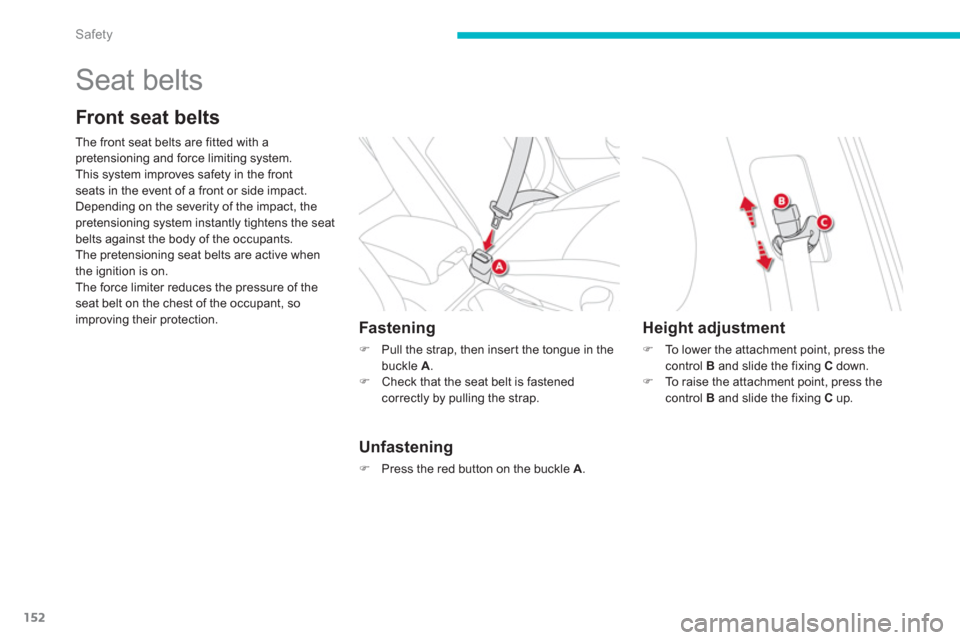
152
Safety
Seat belts
Front seat belts
The front seat belts are fitted with a
pretensioning and force limiting system.
This system improves safety in the front
seats in the event of a front or side impact.
Depending on the severity of the impact, the
pretensioning system instantly tightens the seat
belts against the body of the occupants.
The pretensioning seat belts are active when
the ignition is on.
The force limiter reduces the pressure of the
seat belt on the chest of the occupant, so
improving their protection.
Fastening
�)
Pull the strap, then insert the tongue in the
buckle A
.
�)
Check that the seat belt is fastened
correctly by pulling the strap.
Unfastening
�)
Press the red button on the buckle A
.
Height adjustment
�)
To lower the attachment point, press the
control B
and slide the fixing C
down.
�)
To raise the attachment point, press the
control B
and slide the fixing C
up.
Page 155 of 368
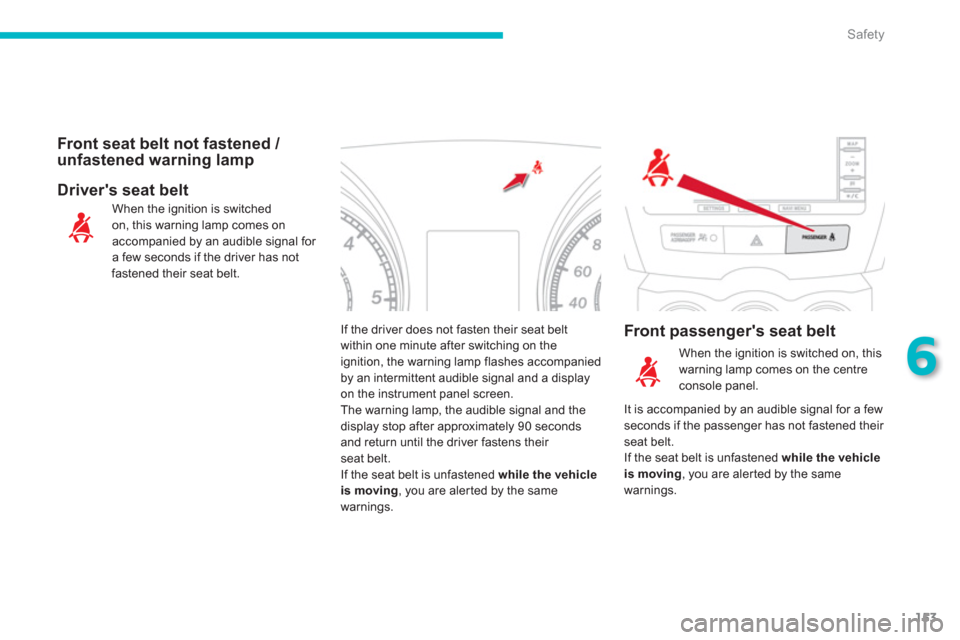
153
6
Safety
If the driver does not fasten their seat belt
within one minute after switching on the
ignition, the warning lamp flashes accompanied
by an intermittent audible signal and a display
on the instrument panel screen.
The warning lamp, the audible signal and the
display stop after approximately 90 seconds
and return until the driver fastens their
seat belt.
If the seat belt is unfastened while the vehicle
is moving
, you are alerted by the same
warnings. When the ignition is switched
on, this warning lamp comes on
accompanied by an audible signal for
a few seconds if the driver has not
fastened their seat belt.
Front seat belt not fastened /
unfastened warning lamp
Front passenger's seat belt
Driver's seat belt
When the ignition is switched on, this
warning lamp comes on the centre
console panel.
It is accompanied by an audible signal for a few
seconds if the passenger has not fastened their
seat belt.
If the seat belt is unfastened while the vehicle
is moving
, you are alerted by the same
warnings.
Page 158 of 368
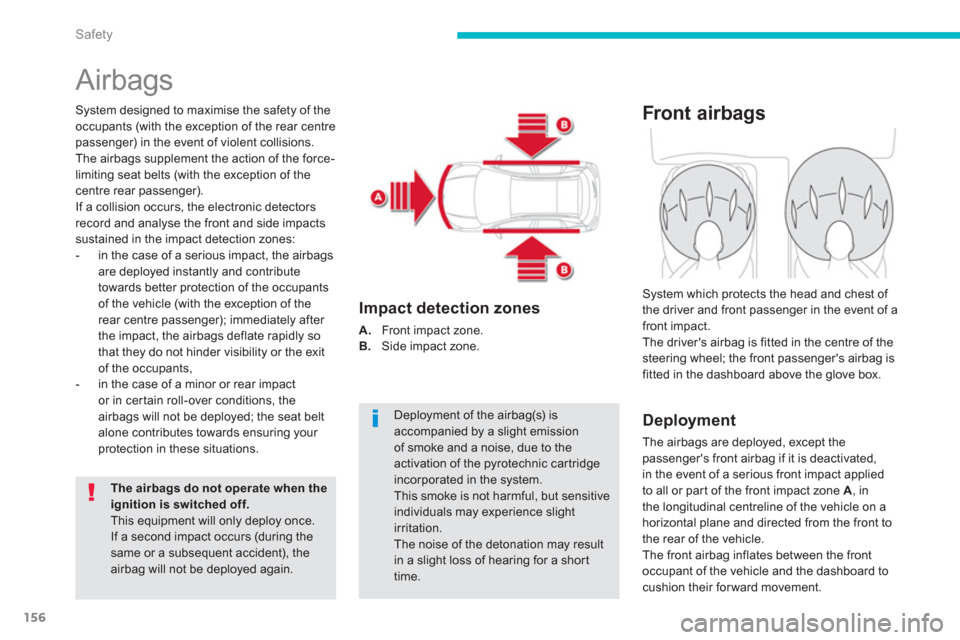
156
Safety
Airbags
System designed to maximise the safety of the
occupants (with the exception of the rear centre
passenger) in the event of violent collisions.
The airbags supplement the action of the force-
limiting seat belts (with the exception of the
centre rear passenger).
If a collision occurs, the electronic detectors
record and analyse the front and side impacts
sustained in the impact detection zones:
- in the case of a serious impact, the airbags
are deployed instantly and contribute
towards better protection of the occupants
of the vehicle (with the exception of the
rear centre passenger); immediately after
the impact, the airbags deflate rapidly so
that they do not hinder visibility or the exit
of the occupants,
- in the case of a minor or rear impact
or in certain roll-over conditions, the
airbags will not be deployed; the seat belt
alone contributes towards ensuring your
protection in these situations.
The airbags do not operate when the
ignition is switched off.
This equipment will only deploy once.
If a second impact occurs (during the
same or a subsequent accident), the
airbag will not be deployed again. Deployment of the airbag(s) is
accompanied by a slight emission
of smoke and a noise, due to the
activation of the pyrotechnic cartridge
incorporated in the system.
This smoke is not harmful, but sensitive
individuals may experience slight
irritation.
The noise of the detonation may result
in a slight loss of hearing for a short
time.
Impact detection zones
A.
Front impact zone.
B.
Side impact zone.
Front airbags
Deployment
The airbags are deployed, except the
passenger's front airbag if it is deactivated,
in the event of a serious front impact applied
to all or part of the front impact zone A
, in
the longitudinal centreline of the vehicle on a
horizontal plane and directed from the front to
the rear of the vehicle.
The front airbag inflates between the front
occupant of the vehicle and the dashboard to
cushion their for ward movement. System which protects the head and chest of
the driver and front passenger in the event of a
front impact.
The driver's airbag is fitted in the centre of the
steering wheel; the front passenger's airbag is
fitted in the dashboard above the glove box.
Page 159 of 368
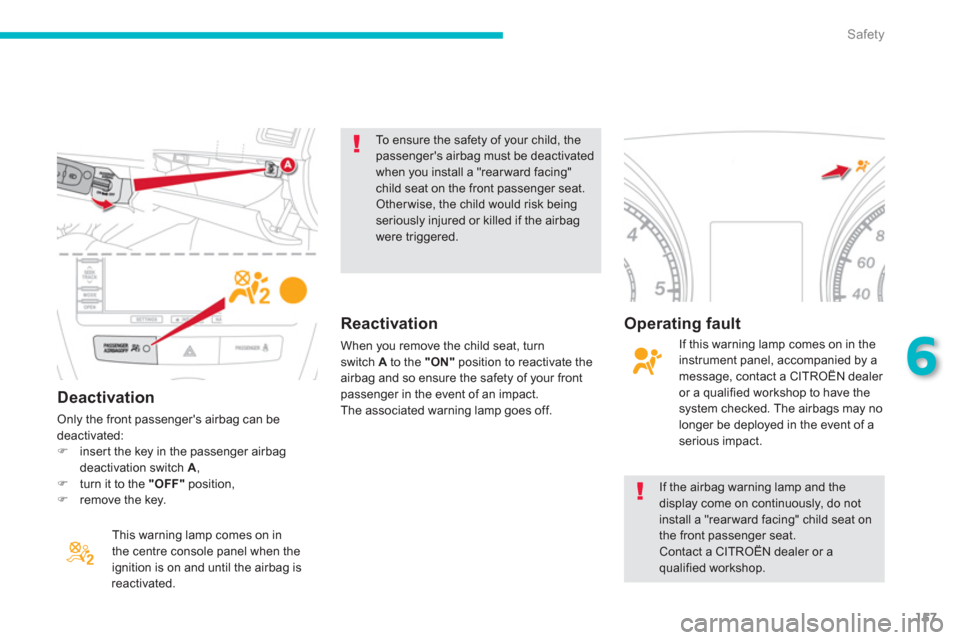
157
6
Safety
Deactivation
Only the front passenger's airbag can be
deactivated:
�)
insert the key in the passenger airbag
deactivation switch A
,
�)
turn it to the "OFF"
position,
�)
remove the key.
This warning lamp comes on in
the centre console panel when the
ignition is on and until the airbag is
reactivated. To ensure the safety of your child, the
passenger's airbag must be deactivated
when you install a "rear ward facing"
child seat on the front passenger seat.
Other wise, the child would risk being
seriously injured or killed if the airbag
were triggered.
If the airbag warning lamp and the
display come on continuously, do not
install a "rear ward facing" child seat on
the front passenger seat.
Contact a CITROËN dealer or a
qualified workshop.
Reactivation
When you remove the child seat, turn
switch A
to the "ON"
position to reactivate the
airbag and so ensure the safety of your front
passenger in the event of an impact.
The associated warning lamp goes off.
Operating fault
If this warning lamp comes on in the
instrument panel, accompanied by a
message, contact a CITROËN dealer
or a qualified workshop to have the
system checked. The airbags may no
longer be deployed in the event of a
serious impact.
Page 180 of 368
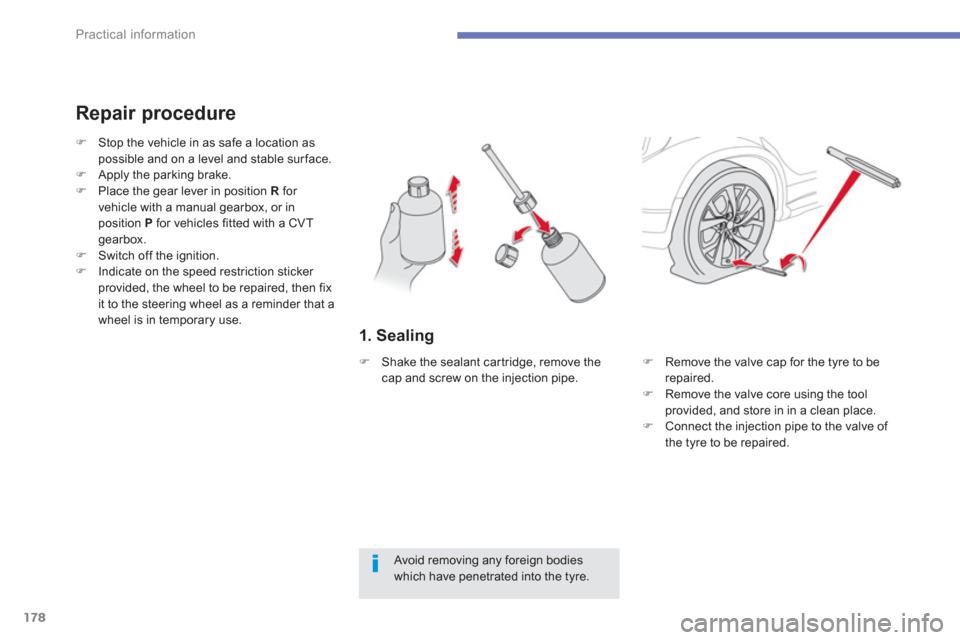
178
Practical information
1. Sealing
Repair procedure
Avoid removing any foreign bodies
which have penetrated into the tyre.
�)
Stop the vehicle in as safe a location as
possible and on a level and stable sur face.
�)
Apply the parking brake.
�)
Place the gear lever in position R
for
vehicle with a manual gearbox, or in
position P
for vehicles fitted with a CVT
gearbox.
�)
Switch off the ignition.
�)
Indicate on the speed restriction sticker
provided, the wheel to be repaired, then fix
it to the steering wheel as a reminder that a
wheel is in temporary use.
�)
Remove the valve cap for the tyre to be
repaired.
�)
Remove the valve core using the tool
provided, and store in in a clean place.
�)
Connect the injection pipe to the valve of
the tyre to be repaired.
�)
Shake the sealant cartridge, remove the
cap and screw on the injection pipe.
Page 182 of 368
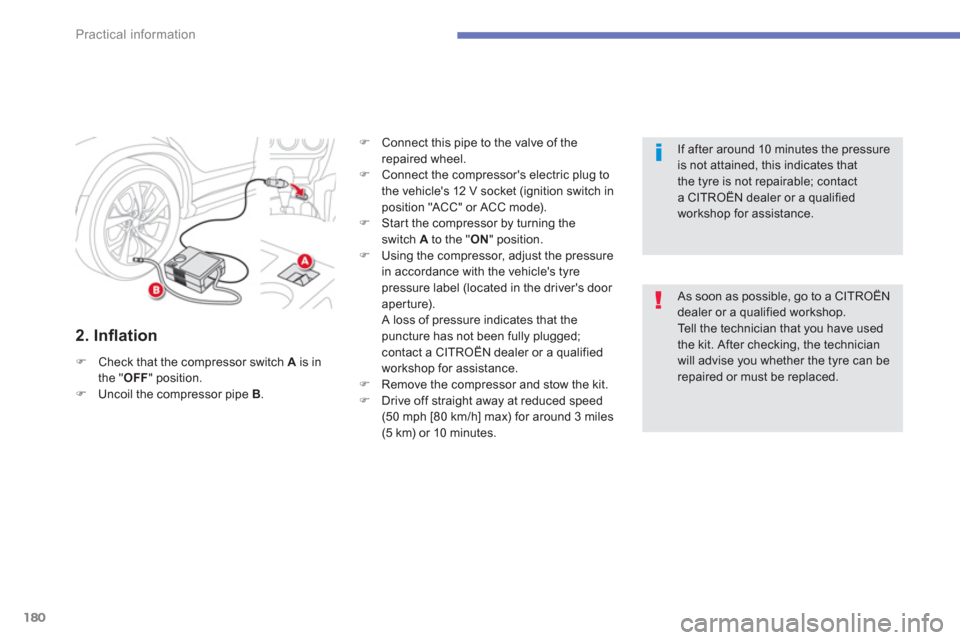
180
Practical information
2. Infl ation
�)
Check that the compressor switch A
is in
the " OFF
" position.
�)
Uncoil the compressor pipe B
.
�)
Connect this pipe to the valve of the
repaired wheel.
�)
Connect the compressor's electric plug to
the vehicle's 12 V socket (ignition switch in
position "ACC" or ACC mode).
�)
Start the compressor by turning the
switch A
to the " ON
" position.
�)
Using the compressor, adjust the pressure
in accordance with the vehicle's tyre
pressure label (located in the driver's door
aperture).
A loss of pressure indicates that the
puncture has not been fully plugged;
contact a CITROËN dealer or a qualified
workshop for assistance.
�)
Remove the compressor and stow the kit.
�)
Drive off straight away at reduced speed
(50 mph [80 km/h] max) for around 3 miles
(5 km) or 10 minutes.
As soon as possible, go to a CITROËN
dealer or a qualified workshop.
Tell the technician that you have used
the kit. After checking, the technician
will advise you whether the tyre can be
repaired or must be replaced.
If after around 10 minutes the pressure
is not attained, this indicates that
the tyre is not repairable; contact
a CITROËN dealer or a qualified
workshop for assistance.
Page 185 of 368
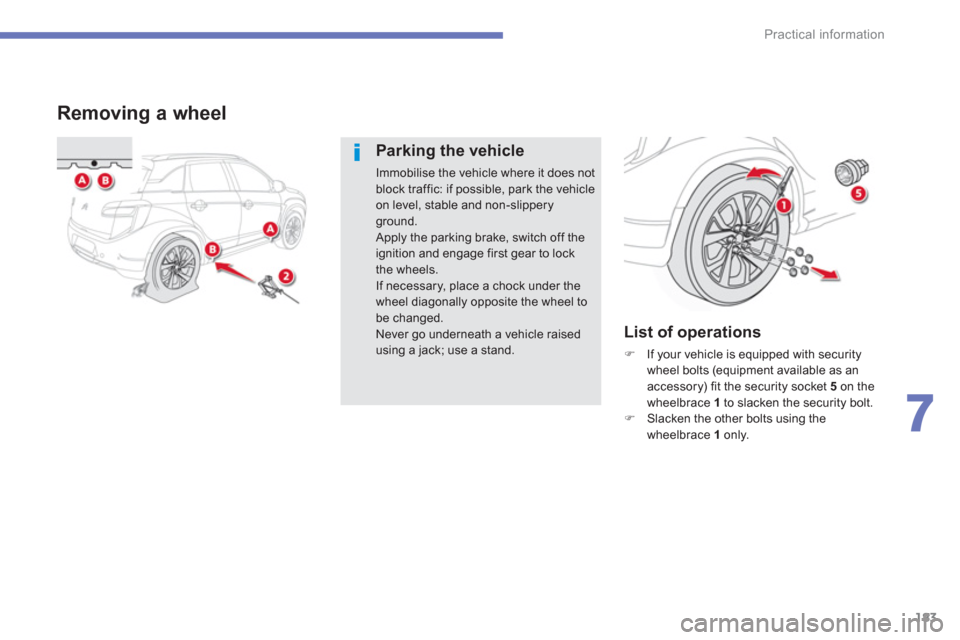
183
7
Practical information
Removing a wheel
Parking the vehicle
Immobilise the vehicle where it does not
block traffic: if possible, park the vehicle
on level, stable and non-slippery
ground.
Apply the parking brake, switch off the
ignition and engage first gear to lock
the wheels.
If necessary, place a chock under the
wheel diagonally opposite the wheel to
be changed.
Never go underneath a vehicle raised
using a jack; use a stand.
List of operations
�)
If your vehicle is equipped with security
wheel bolts (equipment available as an
accessory) fit the security socket 5
on the
wheelbrace 1
to slacken the security bolt.
�)
Slacken the other bolts using the
wheelbrace 1
only.
Page 204 of 368
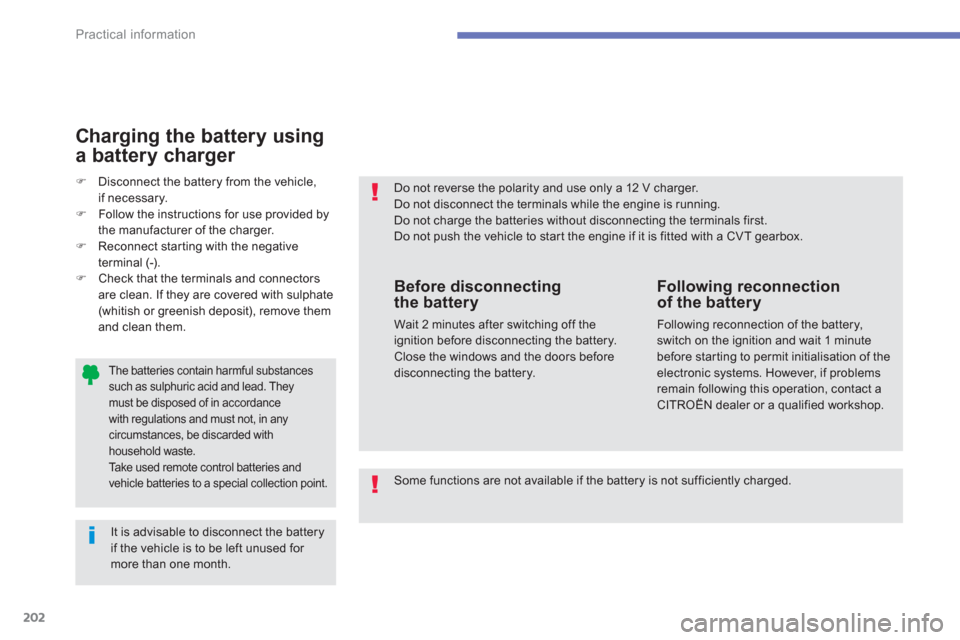
202
Practical information
The batteries contain harmful substances
such as sulphuric acid and lead. They
must be disposed of in accordance
with regulations and must not, in any
circumstances, be discarded with
household waste.
Take used remote control batteries and
vehicle batteries to a special collection point.
Do not reverse the polarity and use only a 12 V charger.
Do not disconnect the terminals while the engine is running.
Do not charge the batteries without disconnecting the terminals first.
Do not push the vehicle to start the engine if it is fitted with a CVT gearbox.
It is advisable to disconnect the battery
if the vehicle is to be left unused for
more than one month.
Before disconnecting
the battery
Wait 2 minutes after switching off the
ignition before disconnecting the battery.
Close the windows and the doors before
disconnecting the battery.
Following reconnection
of the battery
Following reconnection of the battery,
switch on the ignition and wait 1 minute
before starting to permit initialisation of the
electronic systems. However, if problems
remain following this operation, contact a
CITROËN dealer or a qualified workshop.
�)
Disconnect the battery from the vehicle,
if necessary.
�)
Follow the instructions for use provided by
the manufacturer of the charger.
�)
Reconnect starting with the negative
terminal (-).
�)
Check that the terminals and connectors
are clean. If they are covered with sulphate
(whitish or greenish deposit), remove them
and clean them.
Charging the battery using
a battery charger
Some functions are not available if the battery is not sufficiently charged.
Page 205 of 368

203
7
Practical information
Removing a front or rear
wiper blade
�)
Raise the corresponding wiper arm.
�)
Remove the wiper blade, sliding it towards
the outside.
Changing a wiper
blade
Fitting a front or rear wiper
blade
�)
At the front, check the size of the wiper
blade as the shorter blade is fitted on the
right-hand side of the vehicle.
�)
Put the corresponding new wiper blade in
place and fix it.
�)
Fold down the wiper arm carefully.
Automatic power cut-off to accessories
After the engine has stopped, when the
ignition switch is in the "ACC" position
(or the vehicle in "ACC" mode)
you
can still use functions such as the audio
equipment, windscreen wipers, dipped beam
headlamps, courtesy lamps, etc. for about
thirty minutes.
Cutting off
Once the thirty minutes have expired, the
power supply to the accessories will be
automatically cut off.
Restoring power
The power supply will be restored the next time
the ignition is switched on.